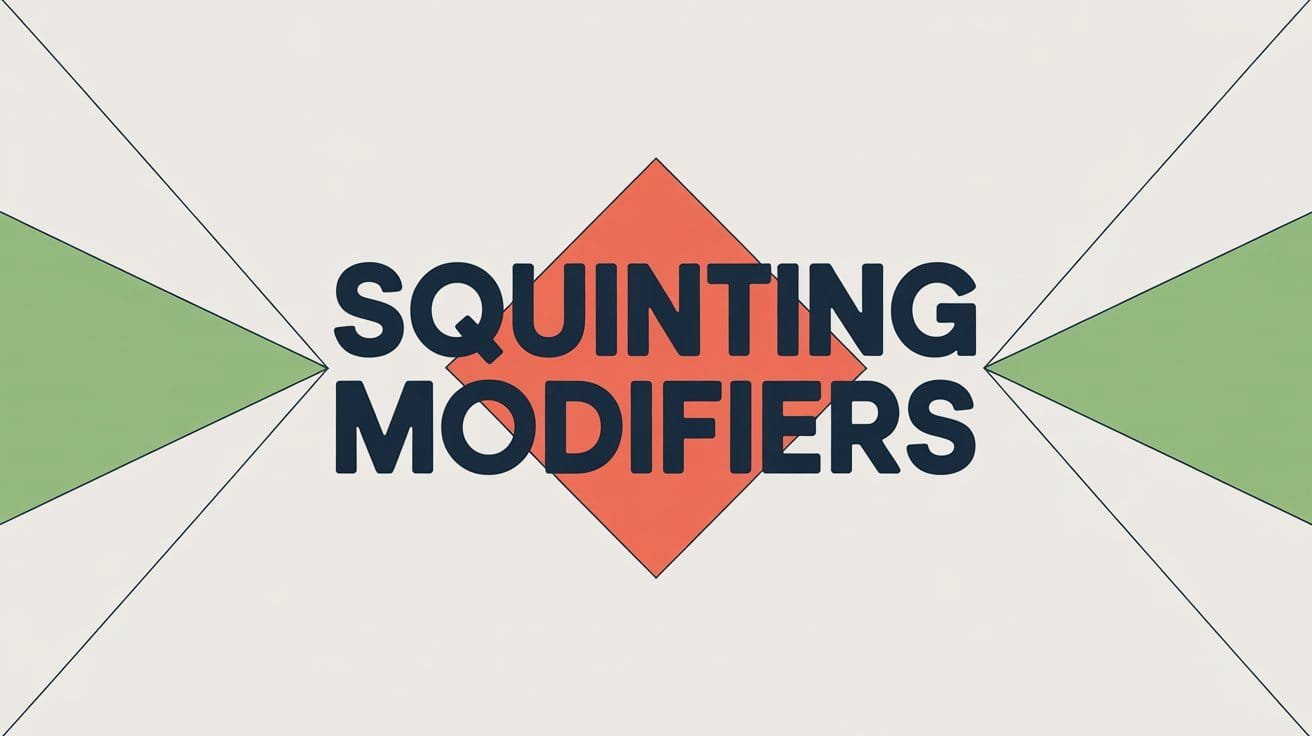Sometimes a single word can make a sentence look two ways at once. That’s what happens with squinting modifiers. It sits awkwardly in the middle of a sentence and seems to describe both what comes before and what comes after it.
Example: Reading this book often improves your vocabulary.
Here, the adverb often can be read two ways:
- reading often improves vocabulary (if you read frequently), or
- reading this book improves vocabulary often (frequent improvement).
The sentence isn’t wrong grammatically, but it’s confusing because “often” is squinting—looking in two directions at once.
Squinting modifiers don’t just make sentences unclear; they slow readers down and weaken your message. This guide will show you what squinting modifiers are, why they cause ambiguity, and how to fix them quickly so your writing stays precise and easy to follow.
What Is a Squinting Modifier?
A squinting modifier is a word or phrase placed in a position where it could modify either the word before it or the word after it. Because it seems to “look both ways,” it creates uncertainty about what exactly is being described.
Unlike misplaced or dangling modifiers, a squinting modifier doesn’t break grammar rules—it just blurs meaning. Readers pause because the sentence can be interpreted in more than one way.
Example: Students who revise essays regularly improve their writing.
The word regularly sits between revise and improve, so it’s unclear whether it modifies revise or improve. If it means revise regularly, students should edit their essays often. If it means improve regularly, their writing skills grow steadily over time.
The fix depends on what you actually mean. You could write: Students who regularly revise essays improve their writing. Or, Students who revise essays improve their writing regularly. A simple shift in placement removes the ambiguity completely.
Common Patterns of Squinting Modifiers
Squinting modifiers usually appear when adverbs or phrases are placed between two verbs or clauses. The result is a sentence that looks balanced but can be read in two different ways. Recognizing these patterns helps you catch them quickly when editing.
Adverbs Between Two Verbs
Adverbs such as often, almost, just, only, and regularly are common offenders.
Example: Running every morning quickly improves endurance.
Does quickly describe running or improves?
- Running quickly every morning improves endurance. (quickly = how they run)
- Running every morning improves endurance quickly. (quickly = how fast results appear)
Modifiers Placed in the Middle of Clauses
When a modifier lands between two ideas, it’s unclear which one it connects to.
Example: Taking notes carefully helps students remember lectures.
Does carefully describe taking notes or helps students remember?
- Carefully taking notes helps students remember lectures.
- Taking notes helps students carefully remember lectures.
Adverbs That Can Float in a Sentence
Certain adverbs can grammatically fit in multiple places, but meaning changes depending on where they land.
Example: He said yesterday he would submit the report.
Did he say it yesterday or will he submit it yesterday (impossible but ambiguous)?
- He said he would submit the report yesterday. (the saying happened earlier)
- Yesterday, he said he would submit the report. (clear time reference)
Phrases That Could Modify Two Parts
Even longer phrases can squint when not placed clearly.
Example: The teacher told the students after the break they could leave.
Was the instruction given after the break or were they allowed to leave after the break?
- After the break, the teacher told the students they could leave.
- The teacher told the students they could leave after the break.
Squinting modifiers can sneak into writing because they sound natural in speech. But in writing, placement must guide the reader clearly—otherwise, one small adverb can change the entire meaning.
Examples of Squinting Modifiers
1. Watching TV occasionally makes people relax.
- Occasionally watching TV makes people relax.
- Watching TV makes people relax occasionally.
2. She said yesterday she would start a new project.
- She said she would start a new project yesterday.
- Yesterday, she said she would start a new project.
3. Taking long walks daily improves concentration.
- Taking daily long walks improves concentration.
- Taking long walks improves concentration daily.
4. Teachers who explain lessons clearly often help students succeed.
- Teachers who often explain lessons clearly help students succeed.
- Teachers who explain lessons clearly help students often.
5. People who read quickly learn new words easily.
- People who quickly read learn new words easily.
- People who read learn new words quickly.
FAQs about Squinting Modifiers
What is a squinting modifier in grammar?
A squinting modifier is a word or phrase (often an adverb) placed between two parts of a sentence so that it could modify either one. This makes the meaning unclear.
Example: Reading this book often improves your vocabulary.
Why is it called a squinting modifier?
It’s called a squinting modifier because it seems to “look” in two directions—toward the words before and after it. Like someone squinting their eyes to focus, the modifier appears uncertain about which part of the sentence it’s describing.
What is the difference between a misplaced modifier and a squinting modifier?
A misplaced modifier clearly points to the wrong word, while a squinting modifier seems to point to two possible words.
Squinting: Running every morning quickly improves endurance.
Misplaced: She almost drove her kids to school every day.



